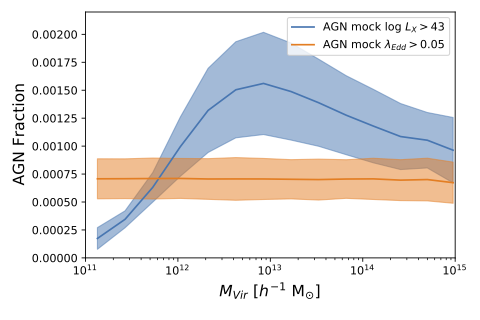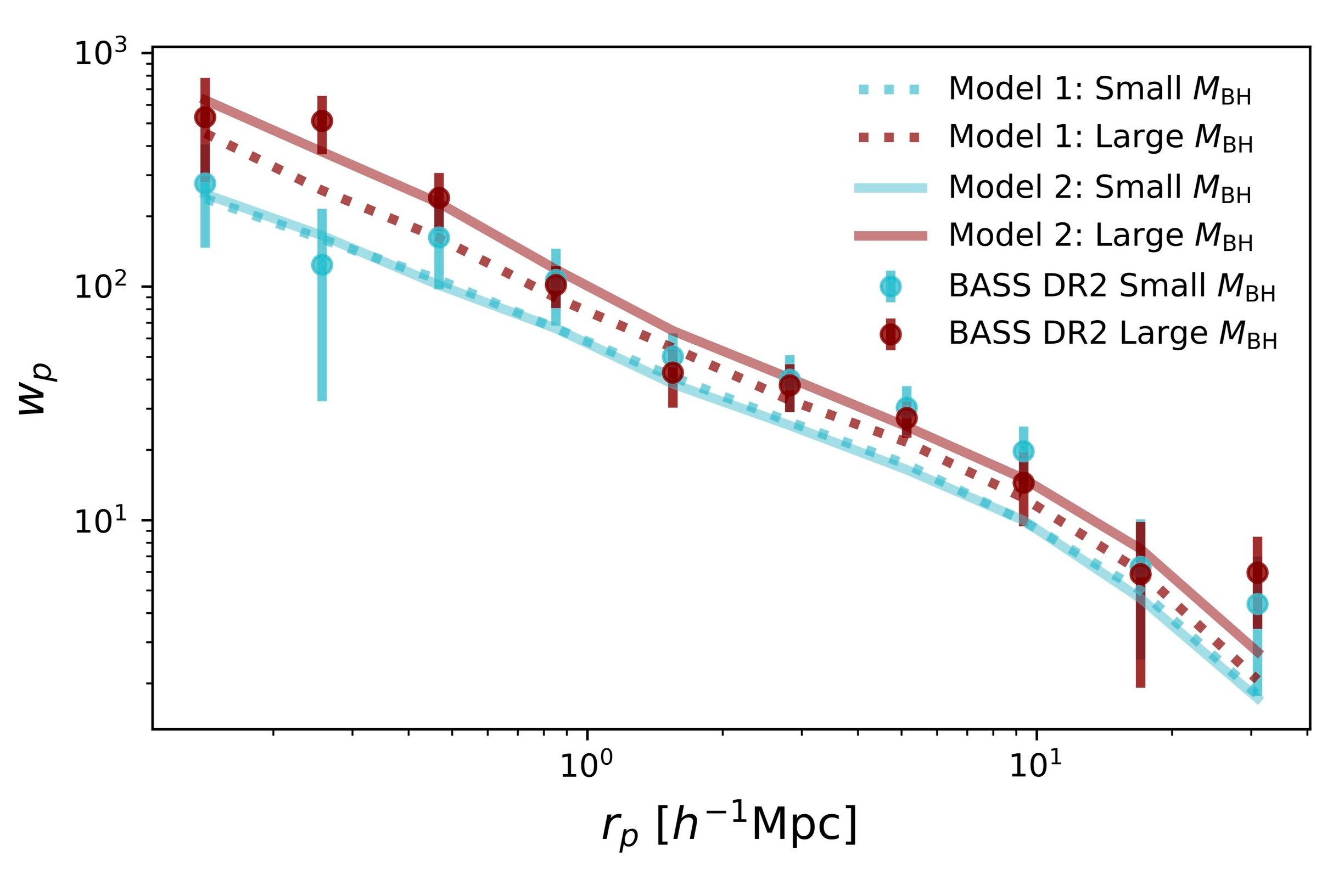Research Overview
My research interests include: fueling and growth of supermassive black holes, AGN feedback, galaxy evolution, multiwavelength surveys, and large-scale structure.
I am a member of the following large collaborations:
Swift/BAT AGN Spectroscopic Survey (BASS; www.bass-survey.com)
Hobby-Eberly Telescope Dark Energy Experiment (HETDEX; hetdex.org)
eROSITA-DE (www.mpe.mpg.de/eROSITA)
Close Agn Reference Survey (CARS; www.cars-survey.org)
Accretion History of AGN (AHA; http://project.ifa.hawaii.edu/aha/)
The impact of AGN X-ray selection on the AGN halo occupation distribution
The connection between AGN and their host dark matter halos provides powerful insights into how supermassive black holes (SMBHs) grow and coevolve with their host galaxies. We investigate the impact of AGN selection on the AGN halo occupation distribution (HOD) by forward-modeling AGN activity into cosmological N-body simulations. By assuming straightforward relationships between the SMBH mass, galaxy mass, and (sub)halo mass, as well as a uniform broken power law distribution of Eddington ratios, we find that luminosity-limited AGN samples result in biased HOD shapes. While AGN defined by an Eddington ratio threshold produce AGN fractions that are flat across halo mass (by definition), luminosity-limited AGN fractions peak around galaxy-group-sized halo masses and then decrease with increasing halo mass. The decline is more rapid for higher luminosity limits and depends on the AGN-halo modeling assumptions. These results are consistent with recent HOD constraints from AGN clustering measurements, which find a shallower rise of the number of satellite AGN with increasing halo mass than for the overall galaxy population. It also naturally explains the constant, characteristic halo mass scale inferred from large-scale AGN clustering amplitudes over a range of redshifts. We conclude that selection biases may be contributing to the inconsistencies between the AGN and galaxy HOD inferred from clustering measurements, rather than the HOD reflecting strong constraints on how supermassive black hole accretion is triggered.
The Black Hole - Halo Connection at z=0
We investigate the connection between supermassive black holes (SMBHs) and their host dark matter halos in the local universe using the clustering statistics and luminosity function of AGN from the Swift/BAT Spectroscopic survey (BASS DR2). By forward-modeling AGN activity into snapshot halo catalogs from N-body simulations, we test a scenario in which SMBH mass correlates with dark matter (sub)halo mass for fixed stellar mass. We compare this to a model absent of this correlation, where stellar mass alone determines the SMBH mass. We find that while both simple models are able to largely reproduce the abundance and overall clustering of AGN, the model in which black hole mass is tightly correlated with halo mass is preferred by the data by ∼ 2σ. When including an independent measurement on the black hole mass–halo mass correlation, this model is preferred by ∼ 5σ. We show that the clustering trends with black hole mass can further break the degeneracies between the two scenarios, and that our preferred model reproduces the measured clustering differences on 1-halo scales between large and small black hole masses. These results indicate that the halo binding energy is fundamentally connected to the growth of supermassive black holes.
Clustering of X-ray Luminous Quasars
The clustering of AGN sheds light on their typical large (Mpc-scale) environments, which can constrain the growth and evolution of supermassive black holes. Here we measure the clustering of luminous X-ray-selected AGN in the Stripe 82X and XMM-XXL-North surveys around the peak epoch of black hole growth, in order to investigate the dependence of luminosity on large-scale AGN environment. We compute the auto-correlation function of AGN in two luminosity bins, 10^43 < L_X < 10^44.5 erg/s at z~0.8 and L_X > 10^44.5 erg/s at z ~1.8, and calculate the AGN bias taking into account the redshift distribution of the sources using three different methods. Our results show that while the less luminous sample has an inferred typical halo mass that is smaller than for the more luminous AGN, the host halo mass may be less dependent on luminosity than suggested in previous work. Focusing on the luminous sample, we calculate a typical host halo mass of ~10^13 Msun, which is similar to previous measurements of moderate-luminosity X-ray AGN and significantly larger than the values found for optical quasars of similar luminosities and redshifts. We suggest that the clustering differences between different AGN selection techniques are dominated by selection biases, and not due to a dependence on AGN luminosity. We discuss the limitations of inferring AGN triggering mechanisms from halo masses derived by large-scale bias.
AGN Clustering in the Local Universe
We characterize the environments of local accreting supermassive black holes by measuring the clustering of AGN in the Swift/BAT Spectroscopic Survey (BASS). With 548 AGN in the redshift range 0.01<z<0.1 over the full sky from the DR1 catalog, BASS provides the largest, least biased sample of local AGN to date due to its hard X-ray selection (14-195 keV) and rich multiwavelength/ancillary data. By measuring the projected cross-correlation function between the AGN and 2MASS galaxies, and interpreting it via halo occupation distribution (HOD) and subhalo-based models, we constrain the occupation statistics of the full sample, as well as in bins of absorbing column density and black hole mass. We find that AGN tend to reside in galaxy group environments, in agreement with previous studies of AGN throughout a large range of luminosity and redshift, and that on average they occupy their dark matter halos similar to inactive galaxies of comparable stellar mass. We also find evidence that obscured AGN tend to reside in denser environments than unobscured AGN, even when samples were matched in luminosity, redshift, stellar mass, and Eddington ratio. We show that this can be explained either by significantly different halo occupation distributions or statistically different host halo assembly histories. Lastly, we see that massive black holes are slightly more likely to reside in central galaxies than black holes of smaller mass.
Searching for Quasar-driven Superbubbles
We search for evidence of hot gas bubbles as signatures for galaxy-scale outflows in two nearby luminous unobscured (type 1) AGN from the Close AGN Reference Survey (CARS) by analyzing 200 ks of deep Chandra observations. The two targets, HE 0227-0931 and HE 0351+0240, were selected to show intriguing kpc-scale arc-like features of extended ionized gas as mapped with VLT-MUSE. By measuring the spatial and spectral properties of the extended X-ray emission and comparing with the sub kpc-scale IFU data, we are able to constrain feedback scenarios and directly test if the ionized gas is due to a shocked wind. However, no extended hot gas emission could be detected. Unless the ambient medium density is low (~0.1 cm^-3 at 1 kpc), the inferred upper limits on the extended X-ray luminosities are well below what is expected from theory at matching AGN luminosities. We conclude that the highly-ionized gas structures on kpc scales are not inflated by a hot outflow, and likely caused by photo-ionization of pre-existing gas streams of different origins. Our non-detection suggests that extended X-ray emission from a AGN-driven wind is not universal, and may lead to conflicts with current theoretical predictions.
Galaxy and AGN Host Morphology at z~1
We study the significance of mergers in the quenching of star formation in galaxies at z˜ 1 by examining their color-mass distributions for different morphology types. We perform two-dimensional light profile fits to GOODS iz images of ˜5000 galaxies and X-ray selected active galactic nucleus (AGN) hosts in the CANDELS/GOODS-north and south fields in the redshift range 0.7< z< 1.3. Distinguishing between bulge-dominated and disk-dominated morphologies, we find that disks and spheroids have distinct color-mass distributions, in agreement with studies at z˜ 0. The smooth distribution across colors for the disk galaxies corresponds to a slow exhaustion of gas, with no fast quenching event. Meanwhile, blue spheroids most likely come from major mergers of star-forming disk galaxies, and the dearth of spheroids at intermediate green colors is suggestive of rapid quenching. The distribution of moderate luminosity X-ray AGN hosts is even across colors, in contrast, and we find similar numbers and distributions among the two morphology types with no apparent dependence on Eddington ratio. The high fraction of bulge-dominated galaxies that host an AGN in the blue cloud and green valley is consistent with the scenario in which the AGN is triggered after a major merger, and the host galaxy then quickly evolves into the green valley. This suggests AGN feedback may play a role in the quenching of star formation in the minority of galaxies that undergo major mergers.





